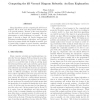Free Online Productivity Tools
i2Speak
i2Symbol
i2OCR
iTex2Img
iWeb2Print
iWeb2Shot
i2Type
iPdf2Split
iPdf2Merge
i2Bopomofo
i2Arabic
i2Style
i2Image
i2PDF
iLatex2Rtf
Sci2ools
95
Voted
ISVD
2007
IEEE
2007
IEEE
Computing the 3D Voronoi Diagram Robustly: An Easy Explanation
Many algorithms exist for computing the 3D Voronoi diagram, but in most cases they assume that the input is in general position. Because of the many degeneracies that arise in 3D geometric computing, their implementation is still problematic in practice. In this paper, I describe a simple 3D Voronoi diagram (and Delaunay tetrahedralization) algorithm, and I explain, by giving as many details and insights as possible, how to ensure that it outputs a correct structure, regardless of the spatial distribution of the points in the input.
| Added | 04 Jun 2010 |
| Updated | 04 Jun 2010 |
| Type | Conference |
| Year | 2007 |
| Where | ISVD |
| Authors | Hugo Ledoux |
Comments (0)

